The Revolutionary Period in Europe: Child Labor in Great Britain Essay
VerifiedAdded on 2021/04/17
|11
|2683
|84
Essay
AI Summary
This essay provides an in-depth analysis of child labor during the Industrial Revolution in Great Britain. It examines the social, economic, and political factors that contributed to the widespread exploitation of children in factories and mines. The essay discusses the harsh working conditions, long hours, and lack of safety regulations that characterized child labor during this period. It also explores the various factors that led to the decline of child labor, including government regulations like the Factory Acts, changing social attitudes, and the rise of educational opportunities. Furthermore, the essay highlights the significant impact of child labor on the children's lives, the families, and the overall development of Great Britain during the revolutionary period. It concludes by emphasizing the significance of the child labor and its eventual decline after the revolutionary period.
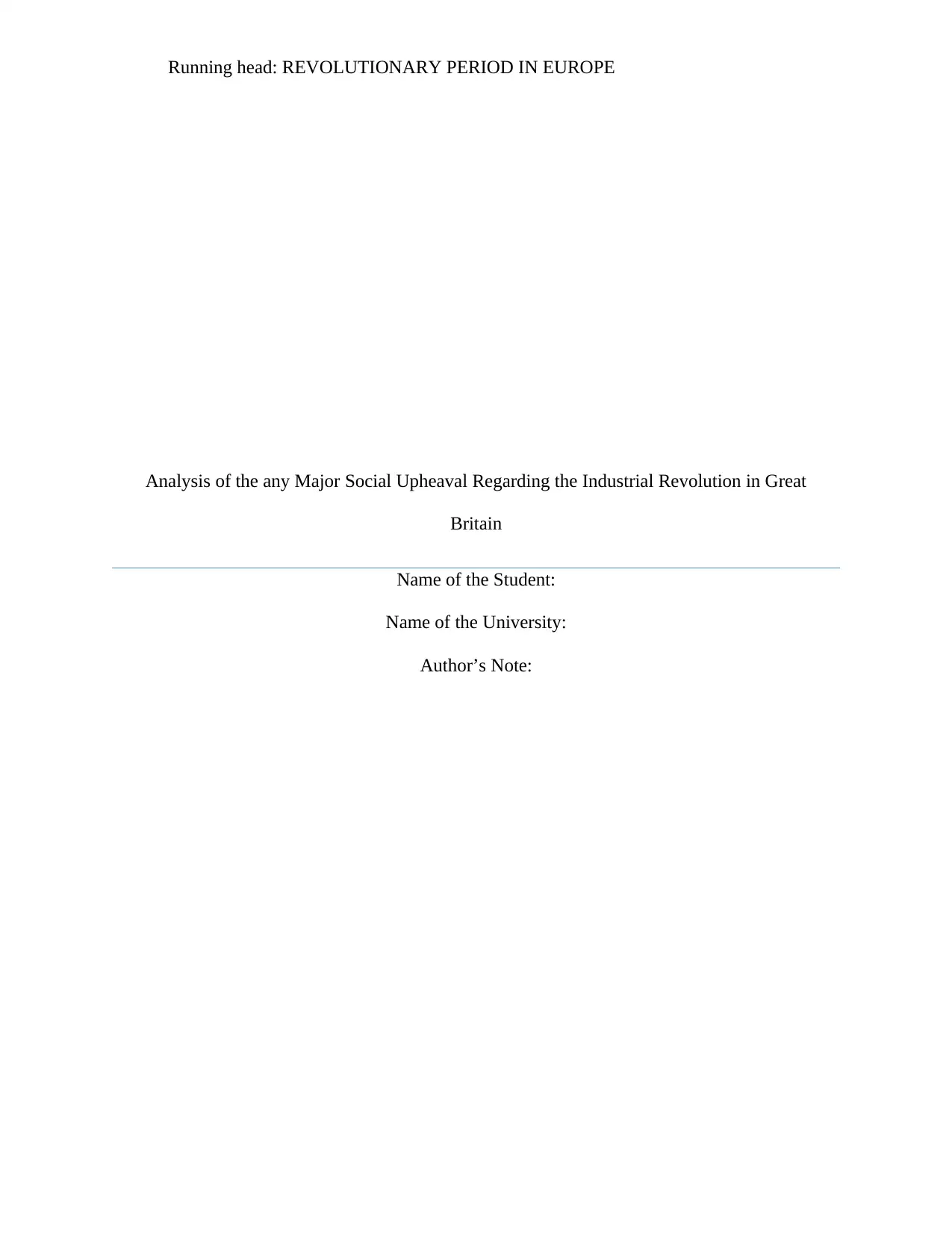
Running head: REVOLUTIONARY PERIOD IN EUROPE
Analysis of the any Major Social Upheaval Regarding the Industrial Revolution in Great
Britain
Name of the Student:
Name of the University:
Author’s Note:
Analysis of the any Major Social Upheaval Regarding the Industrial Revolution in Great
Britain
Name of the Student:
Name of the University:
Author’s Note:
Paraphrase This Document
Need a fresh take? Get an instant paraphrase of this document with our AI Paraphraser
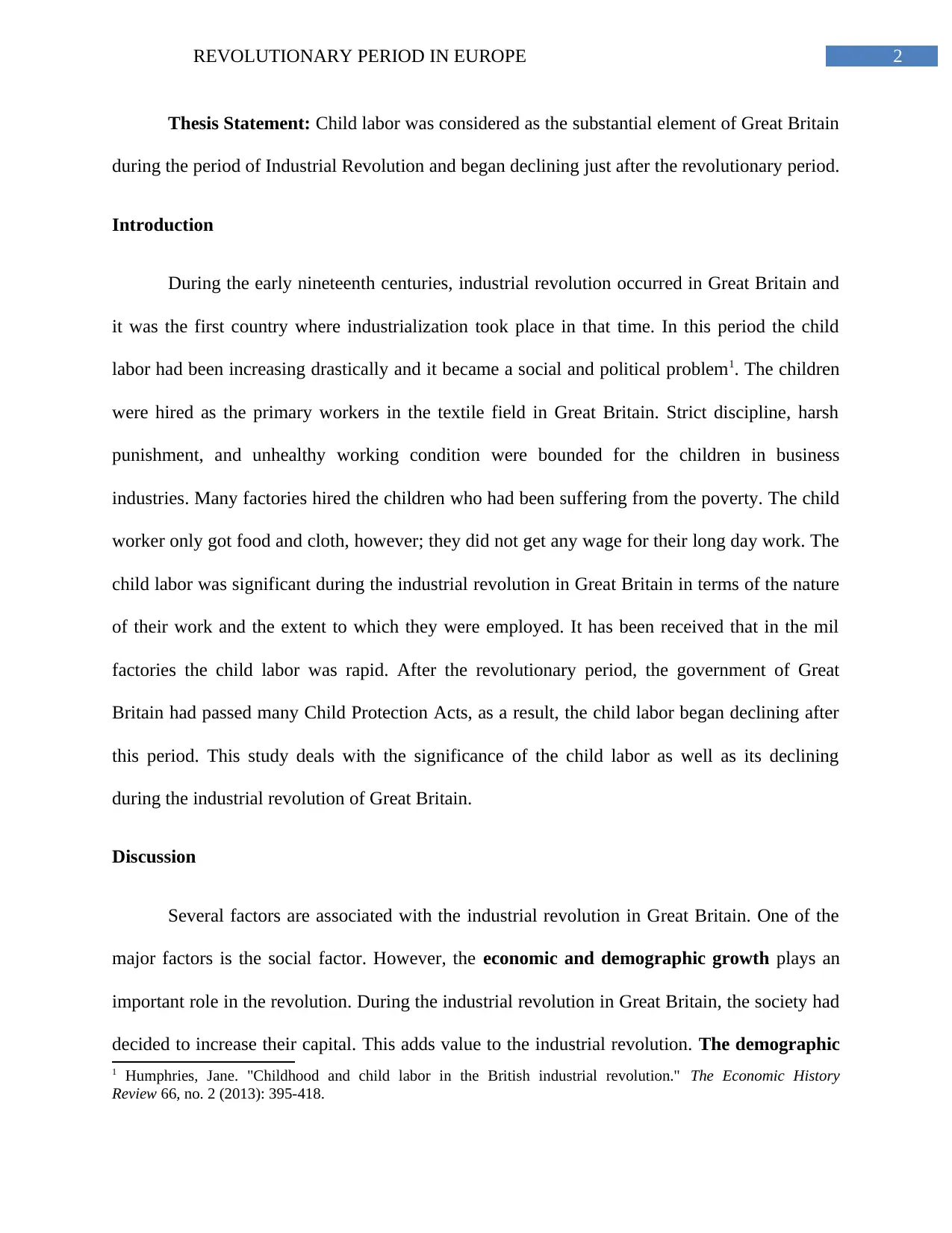
2REVOLUTIONARY PERIOD IN EUROPE
Thesis Statement: Child labor was considered as the substantial element of Great Britain
during the period of Industrial Revolution and began declining just after the revolutionary period.
Introduction
During the early nineteenth centuries, industrial revolution occurred in Great Britain and
it was the first country where industrialization took place in that time. In this period the child
labor had been increasing drastically and it became a social and political problem1. The children
were hired as the primary workers in the textile field in Great Britain. Strict discipline, harsh
punishment, and unhealthy working condition were bounded for the children in business
industries. Many factories hired the children who had been suffering from the poverty. The child
worker only got food and cloth, however; they did not get any wage for their long day work. The
child labor was significant during the industrial revolution in Great Britain in terms of the nature
of their work and the extent to which they were employed. It has been received that in the mil
factories the child labor was rapid. After the revolutionary period, the government of Great
Britain had passed many Child Protection Acts, as a result, the child labor began declining after
this period. This study deals with the significance of the child labor as well as its declining
during the industrial revolution of Great Britain.
Discussion
Several factors are associated with the industrial revolution in Great Britain. One of the
major factors is the social factor. However, the economic and demographic growth plays an
important role in the revolution. During the industrial revolution in Great Britain, the society had
decided to increase their capital. This adds value to the industrial revolution. The demographic
1 Humphries, Jane. "Childhood and child labor in the British industrial revolution." The Economic History
Review 66, no. 2 (2013): 395-418.
Thesis Statement: Child labor was considered as the substantial element of Great Britain
during the period of Industrial Revolution and began declining just after the revolutionary period.
Introduction
During the early nineteenth centuries, industrial revolution occurred in Great Britain and
it was the first country where industrialization took place in that time. In this period the child
labor had been increasing drastically and it became a social and political problem1. The children
were hired as the primary workers in the textile field in Great Britain. Strict discipline, harsh
punishment, and unhealthy working condition were bounded for the children in business
industries. Many factories hired the children who had been suffering from the poverty. The child
worker only got food and cloth, however; they did not get any wage for their long day work. The
child labor was significant during the industrial revolution in Great Britain in terms of the nature
of their work and the extent to which they were employed. It has been received that in the mil
factories the child labor was rapid. After the revolutionary period, the government of Great
Britain had passed many Child Protection Acts, as a result, the child labor began declining after
this period. This study deals with the significance of the child labor as well as its declining
during the industrial revolution of Great Britain.
Discussion
Several factors are associated with the industrial revolution in Great Britain. One of the
major factors is the social factor. However, the economic and demographic growth plays an
important role in the revolution. During the industrial revolution in Great Britain, the society had
decided to increase their capital. This adds value to the industrial revolution. The demographic
1 Humphries, Jane. "Childhood and child labor in the British industrial revolution." The Economic History
Review 66, no. 2 (2013): 395-418.
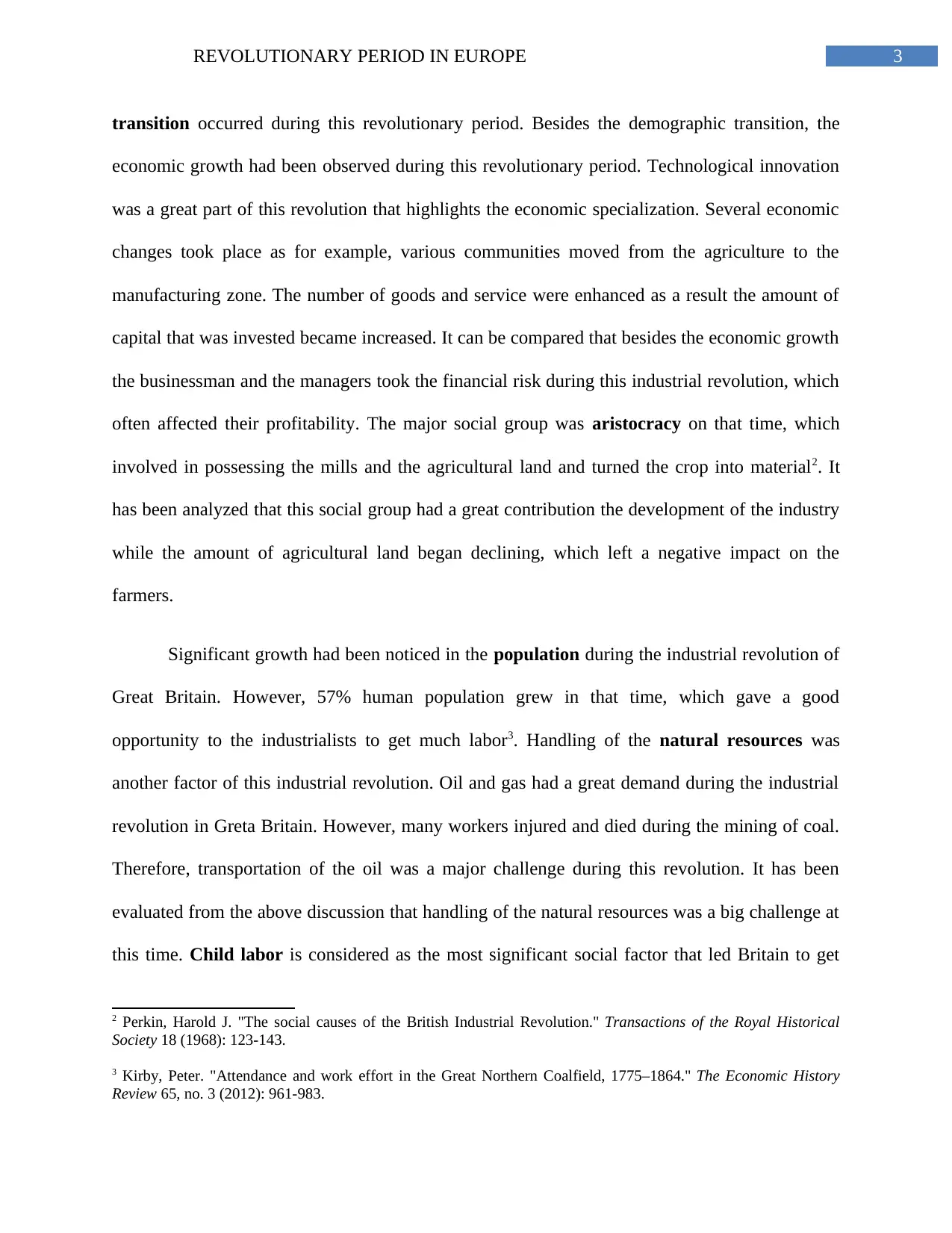
3REVOLUTIONARY PERIOD IN EUROPE
transition occurred during this revolutionary period. Besides the demographic transition, the
economic growth had been observed during this revolutionary period. Technological innovation
was a great part of this revolution that highlights the economic specialization. Several economic
changes took place as for example, various communities moved from the agriculture to the
manufacturing zone. The number of goods and service were enhanced as a result the amount of
capital that was invested became increased. It can be compared that besides the economic growth
the businessman and the managers took the financial risk during this industrial revolution, which
often affected their profitability. The major social group was aristocracy on that time, which
involved in possessing the mills and the agricultural land and turned the crop into material2. It
has been analyzed that this social group had a great contribution the development of the industry
while the amount of agricultural land began declining, which left a negative impact on the
farmers.
Significant growth had been noticed in the population during the industrial revolution of
Great Britain. However, 57% human population grew in that time, which gave a good
opportunity to the industrialists to get much labor3. Handling of the natural resources was
another factor of this industrial revolution. Oil and gas had a great demand during the industrial
revolution in Greta Britain. However, many workers injured and died during the mining of coal.
Therefore, transportation of the oil was a major challenge during this revolution. It has been
evaluated from the above discussion that handling of the natural resources was a big challenge at
this time. Child labor is considered as the most significant social factor that led Britain to get
2 Perkin, Harold J. "The social causes of the British Industrial Revolution." Transactions of the Royal Historical
Society 18 (1968): 123-143.
3 Kirby, Peter. "Attendance and work effort in the Great Northern Coalfield, 1775–1864." The Economic History
Review 65, no. 3 (2012): 961-983.
transition occurred during this revolutionary period. Besides the demographic transition, the
economic growth had been observed during this revolutionary period. Technological innovation
was a great part of this revolution that highlights the economic specialization. Several economic
changes took place as for example, various communities moved from the agriculture to the
manufacturing zone. The number of goods and service were enhanced as a result the amount of
capital that was invested became increased. It can be compared that besides the economic growth
the businessman and the managers took the financial risk during this industrial revolution, which
often affected their profitability. The major social group was aristocracy on that time, which
involved in possessing the mills and the agricultural land and turned the crop into material2. It
has been analyzed that this social group had a great contribution the development of the industry
while the amount of agricultural land began declining, which left a negative impact on the
farmers.
Significant growth had been noticed in the population during the industrial revolution of
Great Britain. However, 57% human population grew in that time, which gave a good
opportunity to the industrialists to get much labor3. Handling of the natural resources was
another factor of this industrial revolution. Oil and gas had a great demand during the industrial
revolution in Greta Britain. However, many workers injured and died during the mining of coal.
Therefore, transportation of the oil was a major challenge during this revolution. It has been
evaluated from the above discussion that handling of the natural resources was a big challenge at
this time. Child labor is considered as the most significant social factor that led Britain to get
2 Perkin, Harold J. "The social causes of the British Industrial Revolution." Transactions of the Royal Historical
Society 18 (1968): 123-143.
3 Kirby, Peter. "Attendance and work effort in the Great Northern Coalfield, 1775–1864." The Economic History
Review 65, no. 3 (2012): 961-983.
⊘ This is a preview!⊘
Do you want full access?
Subscribe today to unlock all pages.

Trusted by 1+ million students worldwide
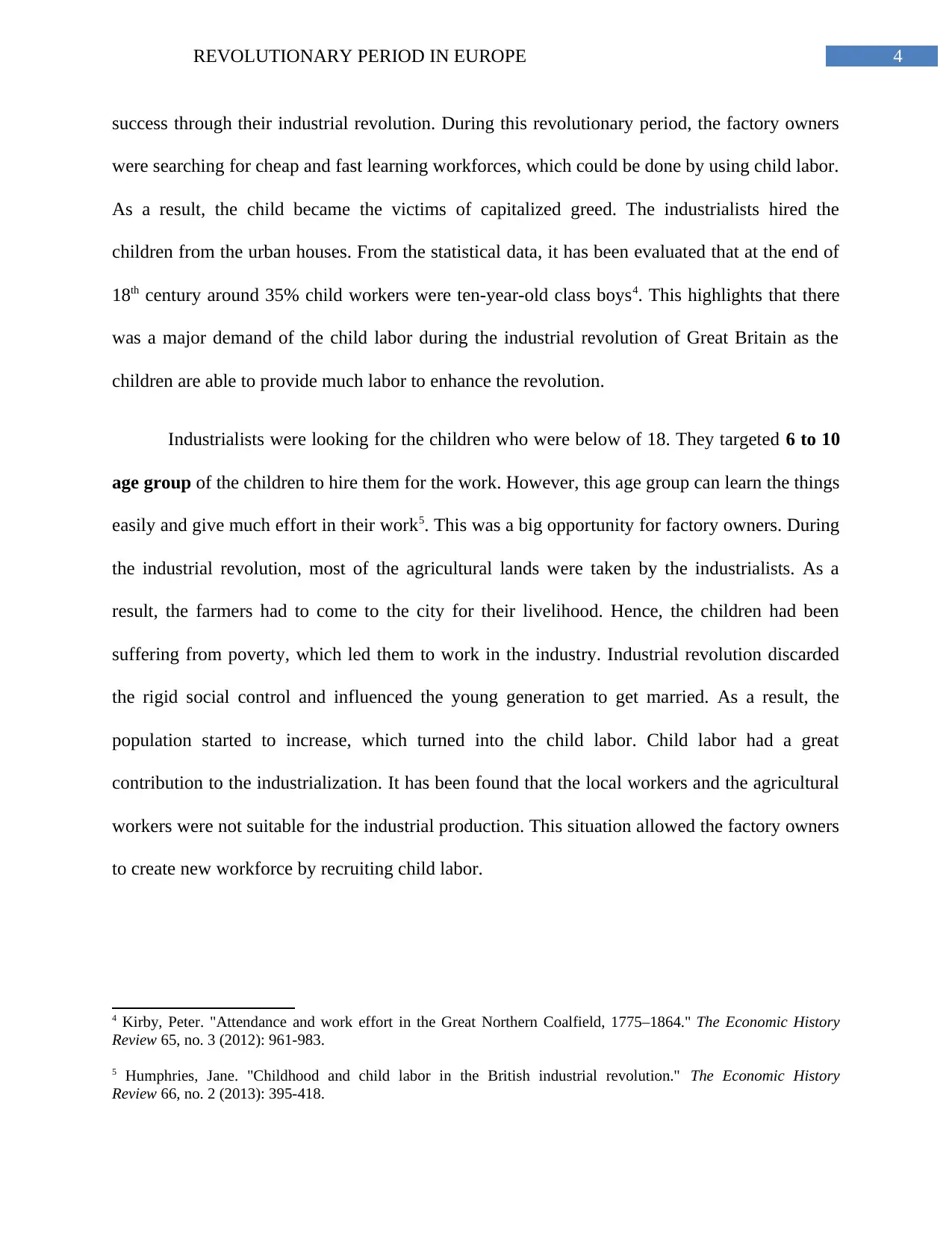
4REVOLUTIONARY PERIOD IN EUROPE
success through their industrial revolution. During this revolutionary period, the factory owners
were searching for cheap and fast learning workforces, which could be done by using child labor.
As a result, the child became the victims of capitalized greed. The industrialists hired the
children from the urban houses. From the statistical data, it has been evaluated that at the end of
18th century around 35% child workers were ten-year-old class boys4. This highlights that there
was a major demand of the child labor during the industrial revolution of Great Britain as the
children are able to provide much labor to enhance the revolution.
Industrialists were looking for the children who were below of 18. They targeted 6 to 10
age group of the children to hire them for the work. However, this age group can learn the things
easily and give much effort in their work5. This was a big opportunity for factory owners. During
the industrial revolution, most of the agricultural lands were taken by the industrialists. As a
result, the farmers had to come to the city for their livelihood. Hence, the children had been
suffering from poverty, which led them to work in the industry. Industrial revolution discarded
the rigid social control and influenced the young generation to get married. As a result, the
population started to increase, which turned into the child labor. Child labor had a great
contribution to the industrialization. It has been found that the local workers and the agricultural
workers were not suitable for the industrial production. This situation allowed the factory owners
to create new workforce by recruiting child labor.
4 Kirby, Peter. "Attendance and work effort in the Great Northern Coalfield, 1775–1864." The Economic History
Review 65, no. 3 (2012): 961-983.
5 Humphries, Jane. "Childhood and child labor in the British industrial revolution." The Economic History
Review 66, no. 2 (2013): 395-418.
success through their industrial revolution. During this revolutionary period, the factory owners
were searching for cheap and fast learning workforces, which could be done by using child labor.
As a result, the child became the victims of capitalized greed. The industrialists hired the
children from the urban houses. From the statistical data, it has been evaluated that at the end of
18th century around 35% child workers were ten-year-old class boys4. This highlights that there
was a major demand of the child labor during the industrial revolution of Great Britain as the
children are able to provide much labor to enhance the revolution.
Industrialists were looking for the children who were below of 18. They targeted 6 to 10
age group of the children to hire them for the work. However, this age group can learn the things
easily and give much effort in their work5. This was a big opportunity for factory owners. During
the industrial revolution, most of the agricultural lands were taken by the industrialists. As a
result, the farmers had to come to the city for their livelihood. Hence, the children had been
suffering from poverty, which led them to work in the industry. Industrial revolution discarded
the rigid social control and influenced the young generation to get married. As a result, the
population started to increase, which turned into the child labor. Child labor had a great
contribution to the industrialization. It has been found that the local workers and the agricultural
workers were not suitable for the industrial production. This situation allowed the factory owners
to create new workforce by recruiting child labor.
4 Kirby, Peter. "Attendance and work effort in the Great Northern Coalfield, 1775–1864." The Economic History
Review 65, no. 3 (2012): 961-983.
5 Humphries, Jane. "Childhood and child labor in the British industrial revolution." The Economic History
Review 66, no. 2 (2013): 395-418.
Paraphrase This Document
Need a fresh take? Get an instant paraphrase of this document with our AI Paraphraser
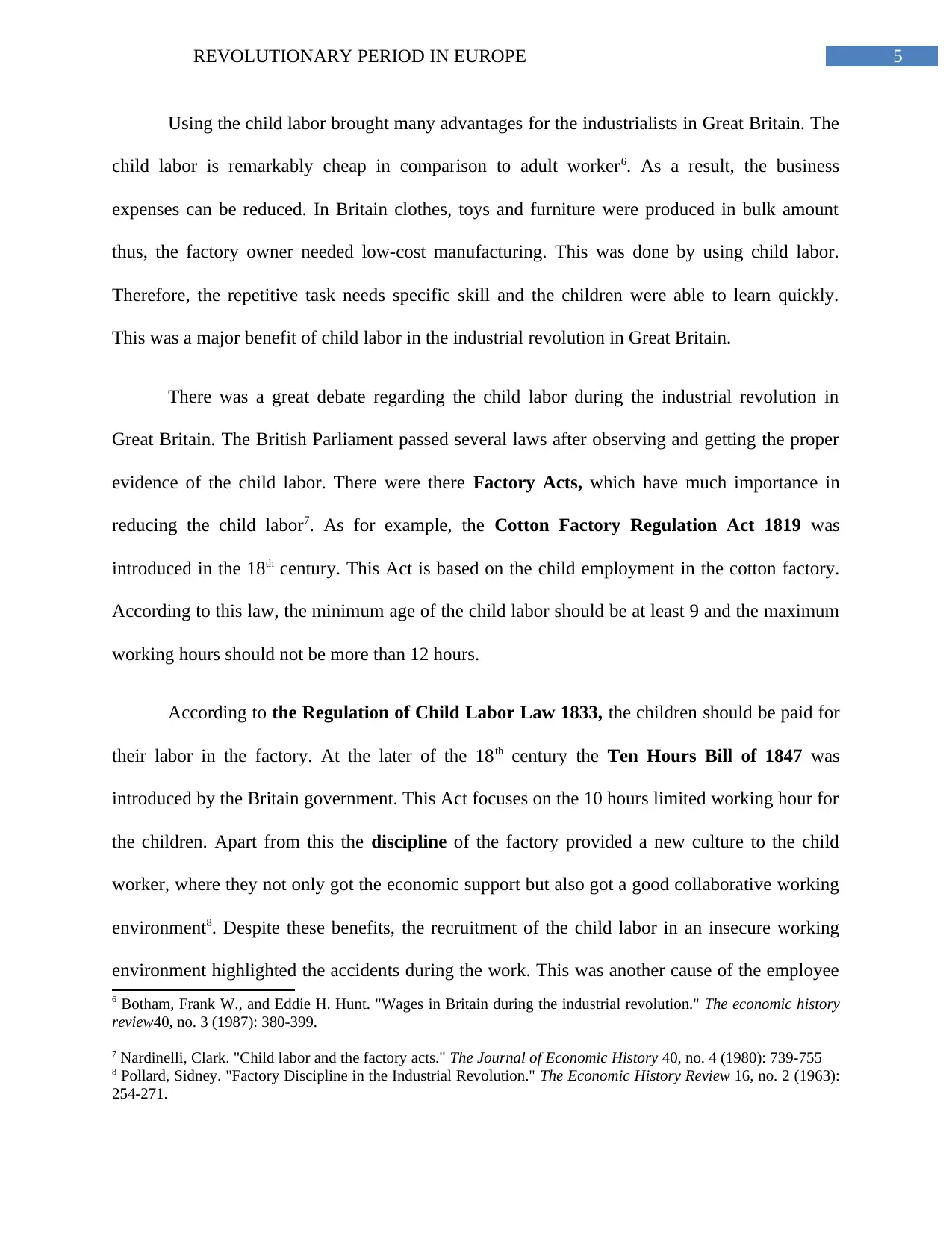
5REVOLUTIONARY PERIOD IN EUROPE
Using the child labor brought many advantages for the industrialists in Great Britain. The
child labor is remarkably cheap in comparison to adult worker6. As a result, the business
expenses can be reduced. In Britain clothes, toys and furniture were produced in bulk amount
thus, the factory owner needed low-cost manufacturing. This was done by using child labor.
Therefore, the repetitive task needs specific skill and the children were able to learn quickly.
This was a major benefit of child labor in the industrial revolution in Great Britain.
There was a great debate regarding the child labor during the industrial revolution in
Great Britain. The British Parliament passed several laws after observing and getting the proper
evidence of the child labor. There were there Factory Acts, which have much importance in
reducing the child labor7. As for example, the Cotton Factory Regulation Act 1819 was
introduced in the 18th century. This Act is based on the child employment in the cotton factory.
According to this law, the minimum age of the child labor should be at least 9 and the maximum
working hours should not be more than 12 hours.
According to the Regulation of Child Labor Law 1833, the children should be paid for
their labor in the factory. At the later of the 18th century the Ten Hours Bill of 1847 was
introduced by the Britain government. This Act focuses on the 10 hours limited working hour for
the children. Apart from this the discipline of the factory provided a new culture to the child
worker, where they not only got the economic support but also got a good collaborative working
environment8. Despite these benefits, the recruitment of the child labor in an insecure working
environment highlighted the accidents during the work. This was another cause of the employee
6 Botham, Frank W., and Eddie H. Hunt. "Wages in Britain during the industrial revolution." The economic history
review40, no. 3 (1987): 380-399.
7 Nardinelli, Clark. "Child labor and the factory acts." The Journal of Economic History 40, no. 4 (1980): 739-755
8 Pollard, Sidney. "Factory Discipline in the Industrial Revolution." The Economic History Review 16, no. 2 (1963):
254-271.
Using the child labor brought many advantages for the industrialists in Great Britain. The
child labor is remarkably cheap in comparison to adult worker6. As a result, the business
expenses can be reduced. In Britain clothes, toys and furniture were produced in bulk amount
thus, the factory owner needed low-cost manufacturing. This was done by using child labor.
Therefore, the repetitive task needs specific skill and the children were able to learn quickly.
This was a major benefit of child labor in the industrial revolution in Great Britain.
There was a great debate regarding the child labor during the industrial revolution in
Great Britain. The British Parliament passed several laws after observing and getting the proper
evidence of the child labor. There were there Factory Acts, which have much importance in
reducing the child labor7. As for example, the Cotton Factory Regulation Act 1819 was
introduced in the 18th century. This Act is based on the child employment in the cotton factory.
According to this law, the minimum age of the child labor should be at least 9 and the maximum
working hours should not be more than 12 hours.
According to the Regulation of Child Labor Law 1833, the children should be paid for
their labor in the factory. At the later of the 18th century the Ten Hours Bill of 1847 was
introduced by the Britain government. This Act focuses on the 10 hours limited working hour for
the children. Apart from this the discipline of the factory provided a new culture to the child
worker, where they not only got the economic support but also got a good collaborative working
environment8. Despite these benefits, the recruitment of the child labor in an insecure working
environment highlighted the accidents during the work. This was another cause of the employee
6 Botham, Frank W., and Eddie H. Hunt. "Wages in Britain during the industrial revolution." The economic history
review40, no. 3 (1987): 380-399.
7 Nardinelli, Clark. "Child labor and the factory acts." The Journal of Economic History 40, no. 4 (1980): 739-755
8 Pollard, Sidney. "Factory Discipline in the Industrial Revolution." The Economic History Review 16, no. 2 (1963):
254-271.
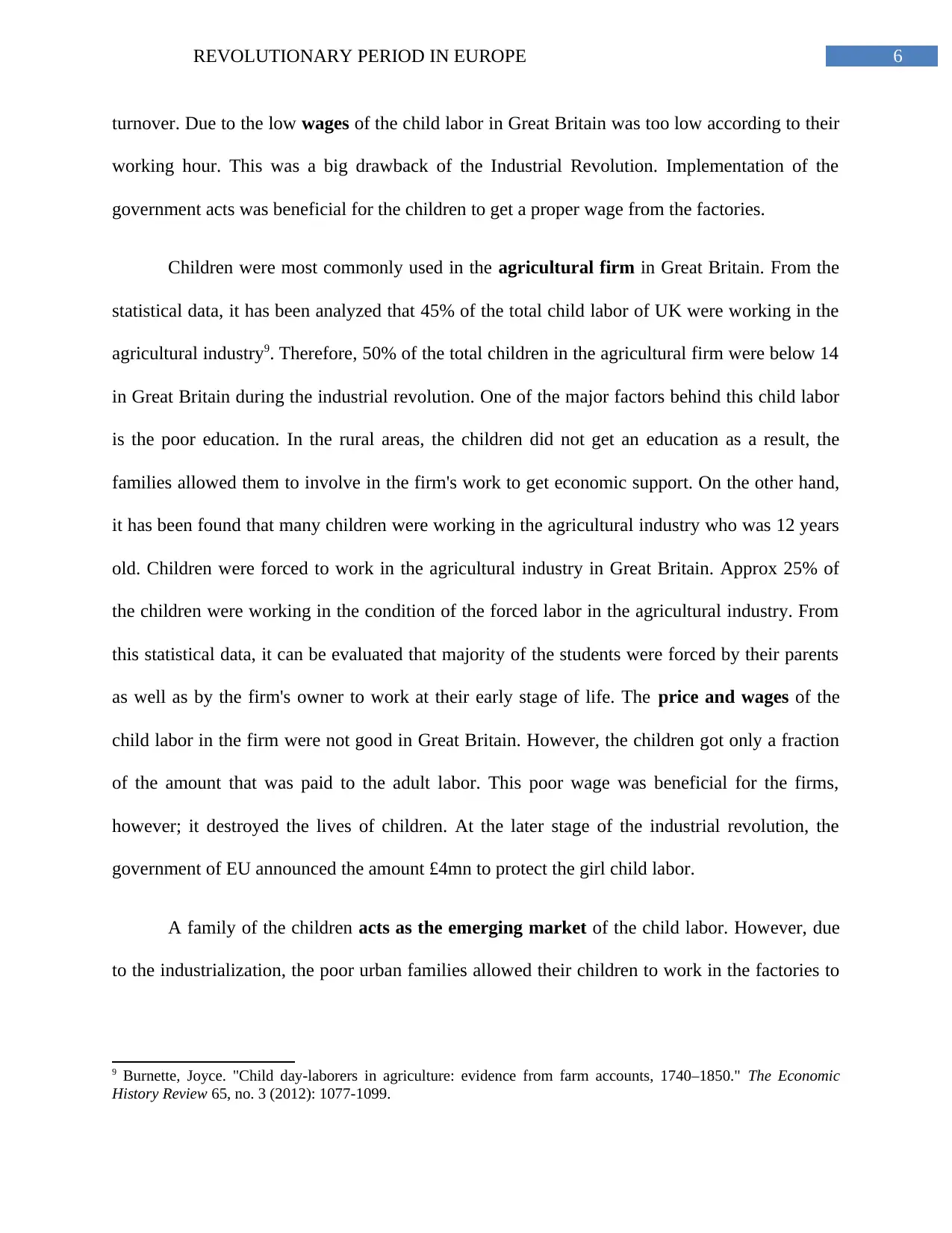
6REVOLUTIONARY PERIOD IN EUROPE
turnover. Due to the low wages of the child labor in Great Britain was too low according to their
working hour. This was a big drawback of the Industrial Revolution. Implementation of the
government acts was beneficial for the children to get a proper wage from the factories.
Children were most commonly used in the agricultural firm in Great Britain. From the
statistical data, it has been analyzed that 45% of the total child labor of UK were working in the
agricultural industry9. Therefore, 50% of the total children in the agricultural firm were below 14
in Great Britain during the industrial revolution. One of the major factors behind this child labor
is the poor education. In the rural areas, the children did not get an education as a result, the
families allowed them to involve in the firm's work to get economic support. On the other hand,
it has been found that many children were working in the agricultural industry who was 12 years
old. Children were forced to work in the agricultural industry in Great Britain. Approx 25% of
the children were working in the condition of the forced labor in the agricultural industry. From
this statistical data, it can be evaluated that majority of the students were forced by their parents
as well as by the firm's owner to work at their early stage of life. The price and wages of the
child labor in the firm were not good in Great Britain. However, the children got only a fraction
of the amount that was paid to the adult labor. This poor wage was beneficial for the firms,
however; it destroyed the lives of children. At the later stage of the industrial revolution, the
government of EU announced the amount £4mn to protect the girl child labor.
A family of the children acts as the emerging market of the child labor. However, due
to the industrialization, the poor urban families allowed their children to work in the factories to
9 Burnette, Joyce. "Child day-laborers in agriculture: evidence from farm accounts, 1740–1850." The Economic
History Review 65, no. 3 (2012): 1077-1099.
turnover. Due to the low wages of the child labor in Great Britain was too low according to their
working hour. This was a big drawback of the Industrial Revolution. Implementation of the
government acts was beneficial for the children to get a proper wage from the factories.
Children were most commonly used in the agricultural firm in Great Britain. From the
statistical data, it has been analyzed that 45% of the total child labor of UK were working in the
agricultural industry9. Therefore, 50% of the total children in the agricultural firm were below 14
in Great Britain during the industrial revolution. One of the major factors behind this child labor
is the poor education. In the rural areas, the children did not get an education as a result, the
families allowed them to involve in the firm's work to get economic support. On the other hand,
it has been found that many children were working in the agricultural industry who was 12 years
old. Children were forced to work in the agricultural industry in Great Britain. Approx 25% of
the children were working in the condition of the forced labor in the agricultural industry. From
this statistical data, it can be evaluated that majority of the students were forced by their parents
as well as by the firm's owner to work at their early stage of life. The price and wages of the
child labor in the firm were not good in Great Britain. However, the children got only a fraction
of the amount that was paid to the adult labor. This poor wage was beneficial for the firms,
however; it destroyed the lives of children. At the later stage of the industrial revolution, the
government of EU announced the amount £4mn to protect the girl child labor.
A family of the children acts as the emerging market of the child labor. However, due
to the industrialization, the poor urban families allowed their children to work in the factories to
9 Burnette, Joyce. "Child day-laborers in agriculture: evidence from farm accounts, 1740–1850." The Economic
History Review 65, no. 3 (2012): 1077-1099.
⊘ This is a preview!⊘
Do you want full access?
Subscribe today to unlock all pages.

Trusted by 1+ million students worldwide
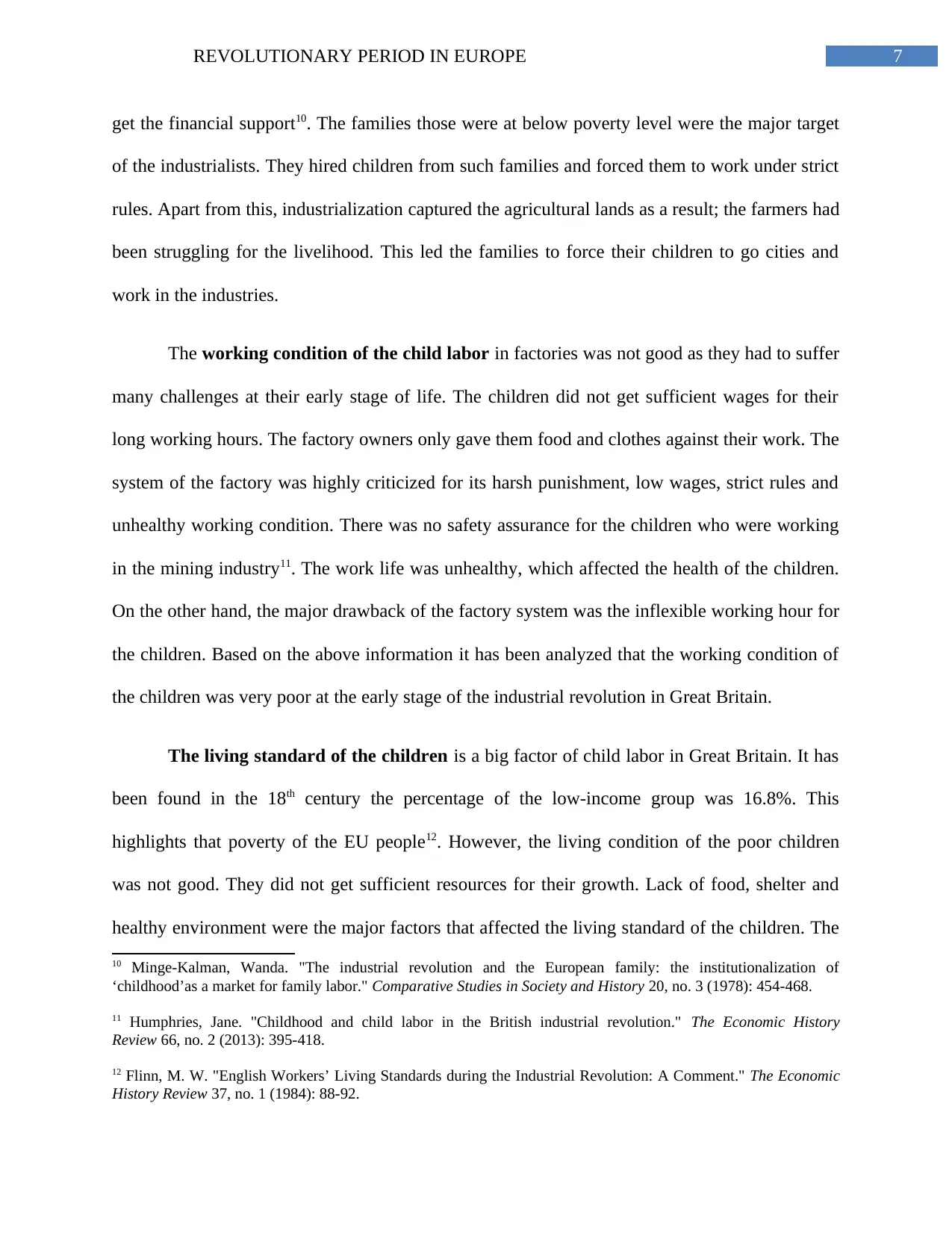
7REVOLUTIONARY PERIOD IN EUROPE
get the financial support10. The families those were at below poverty level were the major target
of the industrialists. They hired children from such families and forced them to work under strict
rules. Apart from this, industrialization captured the agricultural lands as a result; the farmers had
been struggling for the livelihood. This led the families to force their children to go cities and
work in the industries.
The working condition of the child labor in factories was not good as they had to suffer
many challenges at their early stage of life. The children did not get sufficient wages for their
long working hours. The factory owners only gave them food and clothes against their work. The
system of the factory was highly criticized for its harsh punishment, low wages, strict rules and
unhealthy working condition. There was no safety assurance for the children who were working
in the mining industry11. The work life was unhealthy, which affected the health of the children.
On the other hand, the major drawback of the factory system was the inflexible working hour for
the children. Based on the above information it has been analyzed that the working condition of
the children was very poor at the early stage of the industrial revolution in Great Britain.
The living standard of the children is a big factor of child labor in Great Britain. It has
been found in the 18th century the percentage of the low-income group was 16.8%. This
highlights that poverty of the EU people12. However, the living condition of the poor children
was not good. They did not get sufficient resources for their growth. Lack of food, shelter and
healthy environment were the major factors that affected the living standard of the children. The
10 Minge-Kalman, Wanda. "The industrial revolution and the European family: the institutionalization of
‘childhood’as a market for family labor." Comparative Studies in Society and History 20, no. 3 (1978): 454-468.
11 Humphries, Jane. "Childhood and child labor in the British industrial revolution." The Economic History
Review 66, no. 2 (2013): 395-418.
12 Flinn, M. W. "English Workers’ Living Standards during the Industrial Revolution: A Comment." The Economic
History Review 37, no. 1 (1984): 88-92.
get the financial support10. The families those were at below poverty level were the major target
of the industrialists. They hired children from such families and forced them to work under strict
rules. Apart from this, industrialization captured the agricultural lands as a result; the farmers had
been struggling for the livelihood. This led the families to force their children to go cities and
work in the industries.
The working condition of the child labor in factories was not good as they had to suffer
many challenges at their early stage of life. The children did not get sufficient wages for their
long working hours. The factory owners only gave them food and clothes against their work. The
system of the factory was highly criticized for its harsh punishment, low wages, strict rules and
unhealthy working condition. There was no safety assurance for the children who were working
in the mining industry11. The work life was unhealthy, which affected the health of the children.
On the other hand, the major drawback of the factory system was the inflexible working hour for
the children. Based on the above information it has been analyzed that the working condition of
the children was very poor at the early stage of the industrial revolution in Great Britain.
The living standard of the children is a big factor of child labor in Great Britain. It has
been found in the 18th century the percentage of the low-income group was 16.8%. This
highlights that poverty of the EU people12. However, the living condition of the poor children
was not good. They did not get sufficient resources for their growth. Lack of food, shelter and
healthy environment were the major factors that affected the living standard of the children. The
10 Minge-Kalman, Wanda. "The industrial revolution and the European family: the institutionalization of
‘childhood’as a market for family labor." Comparative Studies in Society and History 20, no. 3 (1978): 454-468.
11 Humphries, Jane. "Childhood and child labor in the British industrial revolution." The Economic History
Review 66, no. 2 (2013): 395-418.
12 Flinn, M. W. "English Workers’ Living Standards during the Industrial Revolution: A Comment." The Economic
History Review 37, no. 1 (1984): 88-92.
Paraphrase This Document
Need a fresh take? Get an instant paraphrase of this document with our AI Paraphraser
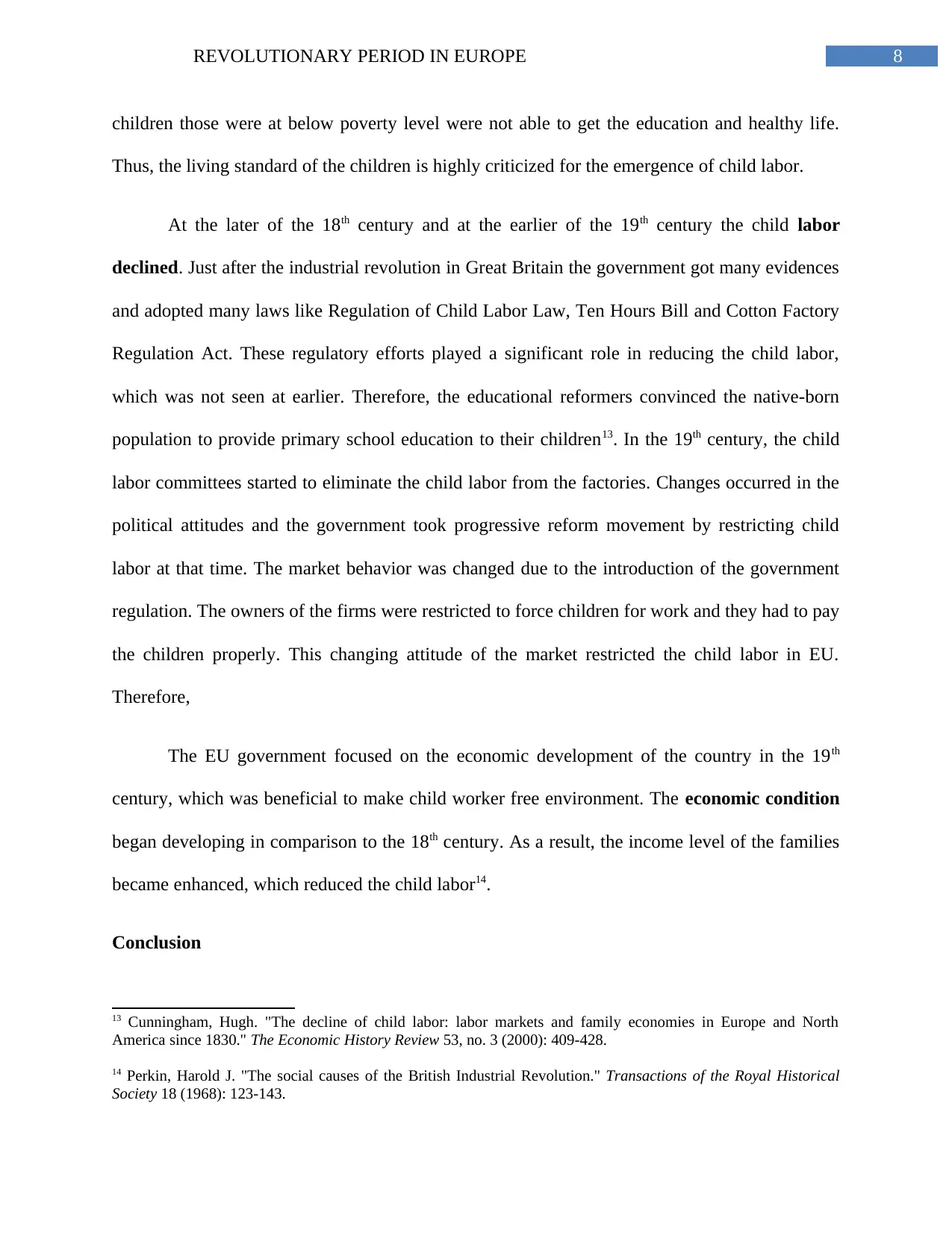
8REVOLUTIONARY PERIOD IN EUROPE
children those were at below poverty level were not able to get the education and healthy life.
Thus, the living standard of the children is highly criticized for the emergence of child labor.
At the later of the 18th century and at the earlier of the 19th century the child labor
declined. Just after the industrial revolution in Great Britain the government got many evidences
and adopted many laws like Regulation of Child Labor Law, Ten Hours Bill and Cotton Factory
Regulation Act. These regulatory efforts played a significant role in reducing the child labor,
which was not seen at earlier. Therefore, the educational reformers convinced the native-born
population to provide primary school education to their children13. In the 19th century, the child
labor committees started to eliminate the child labor from the factories. Changes occurred in the
political attitudes and the government took progressive reform movement by restricting child
labor at that time. The market behavior was changed due to the introduction of the government
regulation. The owners of the firms were restricted to force children for work and they had to pay
the children properly. This changing attitude of the market restricted the child labor in EU.
Therefore,
The EU government focused on the economic development of the country in the 19th
century, which was beneficial to make child worker free environment. The economic condition
began developing in comparison to the 18th century. As a result, the income level of the families
became enhanced, which reduced the child labor14.
Conclusion
13 Cunningham, Hugh. "The decline of child labor: labor markets and family economies in Europe and North
America since 1830." The Economic History Review 53, no. 3 (2000): 409-428.
14 Perkin, Harold J. "The social causes of the British Industrial Revolution." Transactions of the Royal Historical
Society 18 (1968): 123-143.
children those were at below poverty level were not able to get the education and healthy life.
Thus, the living standard of the children is highly criticized for the emergence of child labor.
At the later of the 18th century and at the earlier of the 19th century the child labor
declined. Just after the industrial revolution in Great Britain the government got many evidences
and adopted many laws like Regulation of Child Labor Law, Ten Hours Bill and Cotton Factory
Regulation Act. These regulatory efforts played a significant role in reducing the child labor,
which was not seen at earlier. Therefore, the educational reformers convinced the native-born
population to provide primary school education to their children13. In the 19th century, the child
labor committees started to eliminate the child labor from the factories. Changes occurred in the
political attitudes and the government took progressive reform movement by restricting child
labor at that time. The market behavior was changed due to the introduction of the government
regulation. The owners of the firms were restricted to force children for work and they had to pay
the children properly. This changing attitude of the market restricted the child labor in EU.
Therefore,
The EU government focused on the economic development of the country in the 19th
century, which was beneficial to make child worker free environment. The economic condition
began developing in comparison to the 18th century. As a result, the income level of the families
became enhanced, which reduced the child labor14.
Conclusion
13 Cunningham, Hugh. "The decline of child labor: labor markets and family economies in Europe and North
America since 1830." The Economic History Review 53, no. 3 (2000): 409-428.
14 Perkin, Harold J. "The social causes of the British Industrial Revolution." Transactions of the Royal Historical
Society 18 (1968): 123-143.
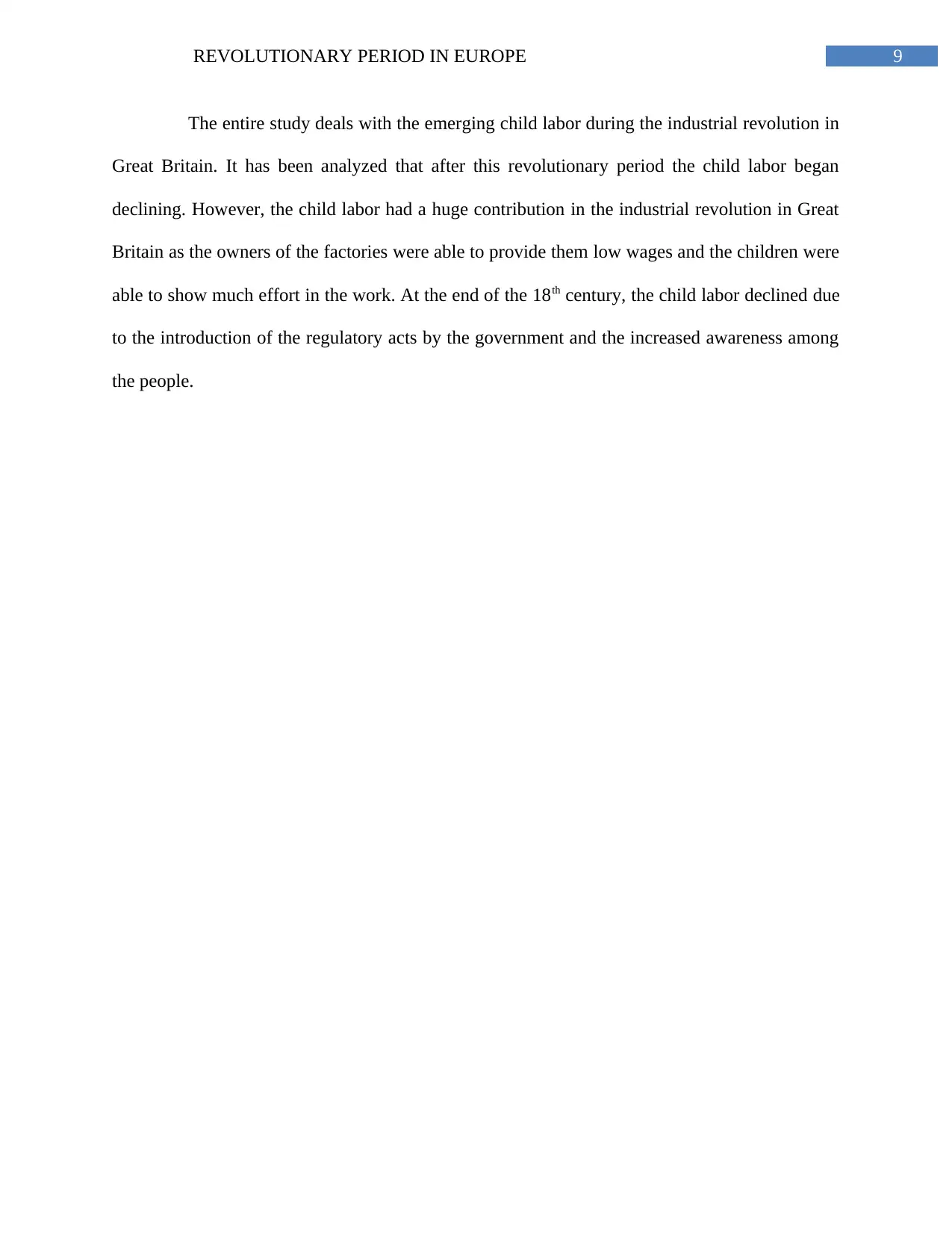
9REVOLUTIONARY PERIOD IN EUROPE
The entire study deals with the emerging child labor during the industrial revolution in
Great Britain. It has been analyzed that after this revolutionary period the child labor began
declining. However, the child labor had a huge contribution in the industrial revolution in Great
Britain as the owners of the factories were able to provide them low wages and the children were
able to show much effort in the work. At the end of the 18th century, the child labor declined due
to the introduction of the regulatory acts by the government and the increased awareness among
the people.
The entire study deals with the emerging child labor during the industrial revolution in
Great Britain. It has been analyzed that after this revolutionary period the child labor began
declining. However, the child labor had a huge contribution in the industrial revolution in Great
Britain as the owners of the factories were able to provide them low wages and the children were
able to show much effort in the work. At the end of the 18th century, the child labor declined due
to the introduction of the regulatory acts by the government and the increased awareness among
the people.
⊘ This is a preview!⊘
Do you want full access?
Subscribe today to unlock all pages.

Trusted by 1+ million students worldwide
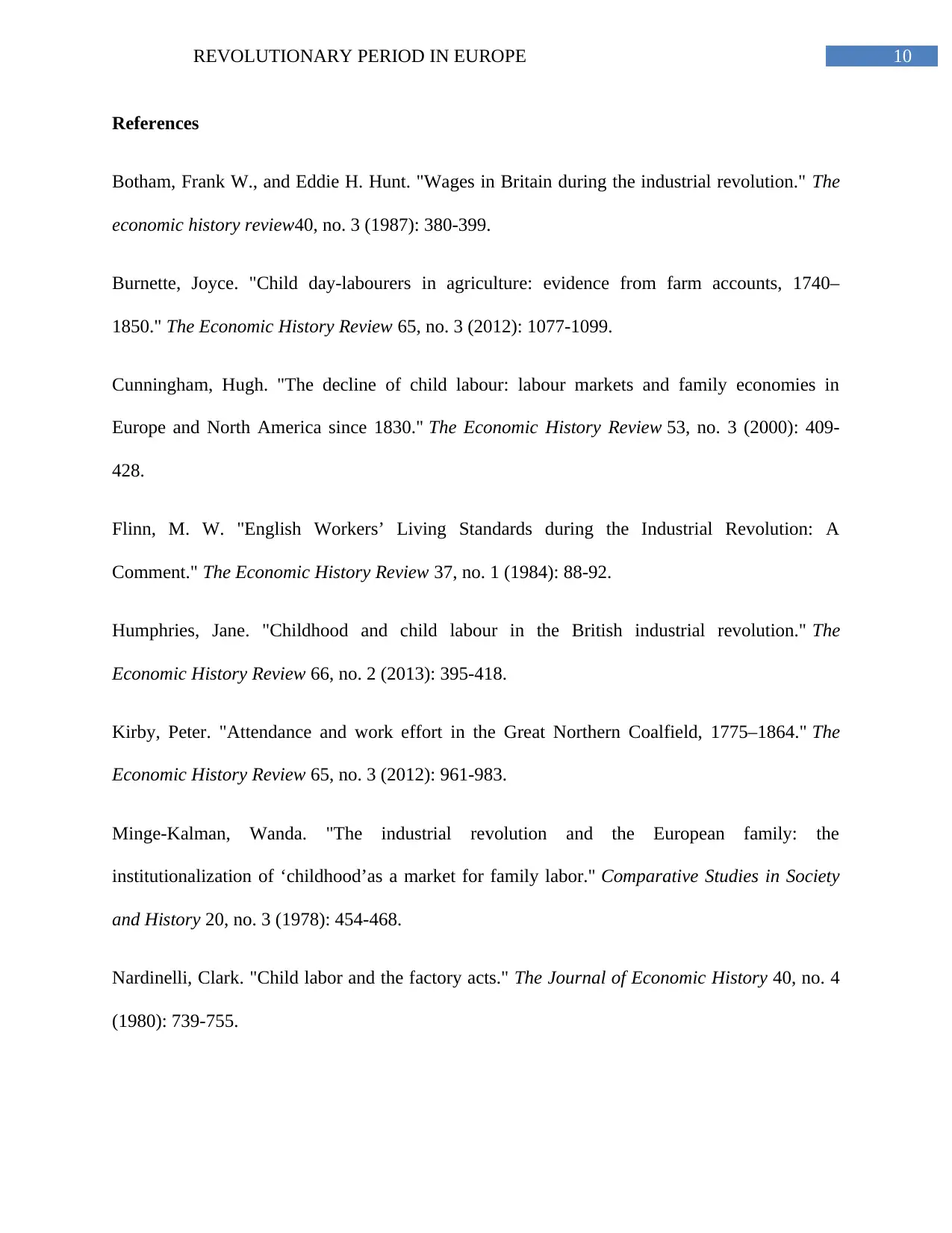
10REVOLUTIONARY PERIOD IN EUROPE
References
Botham, Frank W., and Eddie H. Hunt. "Wages in Britain during the industrial revolution." The
economic history review40, no. 3 (1987): 380-399.
Burnette, Joyce. "Child day‐labourers in agriculture: evidence from farm accounts, 1740–
1850." The Economic History Review 65, no. 3 (2012): 1077-1099.
Cunningham, Hugh. "The decline of child labour: labour markets and family economies in
Europe and North America since 1830." The Economic History Review 53, no. 3 (2000): 409-
428.
Flinn, M. W. "English Workers’ Living Standards during the Industrial Revolution: A
Comment." The Economic History Review 37, no. 1 (1984): 88-92.
Humphries, Jane. "Childhood and child labour in the British industrial revolution." The
Economic History Review 66, no. 2 (2013): 395-418.
Kirby, Peter. "Attendance and work effort in the Great Northern Coalfield, 1775–1864." The
Economic History Review 65, no. 3 (2012): 961-983.
Minge-Kalman, Wanda. "The industrial revolution and the European family: the
institutionalization of ‘childhood’as a market for family labor." Comparative Studies in Society
and History 20, no. 3 (1978): 454-468.
Nardinelli, Clark. "Child labor and the factory acts." The Journal of Economic History 40, no. 4
(1980): 739-755.
References
Botham, Frank W., and Eddie H. Hunt. "Wages in Britain during the industrial revolution." The
economic history review40, no. 3 (1987): 380-399.
Burnette, Joyce. "Child day‐labourers in agriculture: evidence from farm accounts, 1740–
1850." The Economic History Review 65, no. 3 (2012): 1077-1099.
Cunningham, Hugh. "The decline of child labour: labour markets and family economies in
Europe and North America since 1830." The Economic History Review 53, no. 3 (2000): 409-
428.
Flinn, M. W. "English Workers’ Living Standards during the Industrial Revolution: A
Comment." The Economic History Review 37, no. 1 (1984): 88-92.
Humphries, Jane. "Childhood and child labour in the British industrial revolution." The
Economic History Review 66, no. 2 (2013): 395-418.
Kirby, Peter. "Attendance and work effort in the Great Northern Coalfield, 1775–1864." The
Economic History Review 65, no. 3 (2012): 961-983.
Minge-Kalman, Wanda. "The industrial revolution and the European family: the
institutionalization of ‘childhood’as a market for family labor." Comparative Studies in Society
and History 20, no. 3 (1978): 454-468.
Nardinelli, Clark. "Child labor and the factory acts." The Journal of Economic History 40, no. 4
(1980): 739-755.
Paraphrase This Document
Need a fresh take? Get an instant paraphrase of this document with our AI Paraphraser

11REVOLUTIONARY PERIOD IN EUROPE
Perkin, Harold J. "The social causes of the British Industrial Revolution." Transactions of the
Royal Historical Society 18 (1968): 123-143.
Pollard, Sidney. "Factory Discipline in the Industrial Revolution." The Economic History
Review 16, no. 2 (1963): 254-271.
Perkin, Harold J. "The social causes of the British Industrial Revolution." Transactions of the
Royal Historical Society 18 (1968): 123-143.
Pollard, Sidney. "Factory Discipline in the Industrial Revolution." The Economic History
Review 16, no. 2 (1963): 254-271.
1 out of 11
Related Documents
Your All-in-One AI-Powered Toolkit for Academic Success.
+13062052269
info@desklib.com
Available 24*7 on WhatsApp / Email
![[object Object]](/_next/static/media/star-bottom.7253800d.svg)
Unlock your academic potential
Copyright © 2020–2025 A2Z Services. All Rights Reserved. Developed and managed by ZUCOL.





